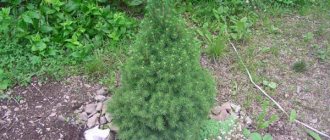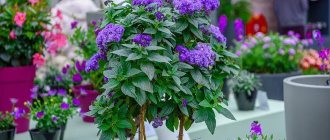These unpretentious and very unique flowers have been cultivated since ancient times. In Russia they have been loved for a long time and are affectionately called “killer whales.” Today we decided to tell readers about how to plant irises, care for them and choose the varieties that are best suited for decorating your site.
Delicate flowers with a wide range of shades are traditionally used to decorate both small areas and park areas.
Time to plant irises
Most irises bloom in early summer. Some varietal hybrids are remontant, blooming later again. Irises should be planted in open ground in mid-summer or closer to autumn (July–October), depending on the climatic conditions of the region. Night temperatures should be +5...+10°C or higher, which gives the plants enough time for good development and rooting before the coming winter. The planting period is chosen so that the plants are dormant after flowering.
Did you know? Not only the iris flower is named after the goddess of the rainbow, but also the chemical element Iridium, the compounds of which also have many color options, and the Iris asteroid, discovered in 1847.
If you buy bare rhizomes or irises in a container at the beginning of the year, then you need to replant them in the ground as soon as possible, without waiting for a convenient time. These are not plants that can be preserved without soil for a long time.
When to plant
Irises are planted both in spring and autumn. Both methods are equally good, but the second method is more suitable for those who are going to plant overgrown irises using the division method.
Spring activities for planting irises are carried out as soon as the earth warms up to +10°C. In the southern regions, they are planted in autumn in mid-October. For central Russia, the optimal period is considered to be the end of August and the beginning of September. In harsh climates, they are planted in the summer in mid-August. The main condition is that the plant has already bloomed and has time to take root before the onset of frost.
Selection and preparation of a site
To ensure abundant flowering, plant iris rhizomes in a sunny location (at least 6 hours a day) with well-drained, fertile and nutritious soil. Flowering will be poor in heavily shaded areas, and poor drainage can lead to bacterial root rot. Planting irises on a slight slope or in raised beds ensures that the flower will not become wet when water stagnates.
The flowers can tolerate full sun for half a day, but this is not an ideal position for the iris. The flowers should not be in the shade of other plants, so it is best to plant them in separate areas designated specifically for irises. They like a nearly neutral pH level or slightly acidic soil and moderate amounts of nitrogen, phosphorus and potassium. Too much nitrogen will promote lush green growth at the expense of flowering.
You may be interested in reading about the characteristics of the Apostolsky iris variety.
Before planting, remove all weeds from the intended garden area. Then loosen the soil to a depth of 30-40 cm to ease the installation of rhizomes and ensure proper drainage and cover with a 5-10 cm layer of compost.
Preparation of planting material
When choosing planting material, consider the color scheme you wish to create in your garden and choose from a wide range of flowers available in shades of pink, white, blue, violet and purple. You can order irises in online stores or purchase them in nurseries.
Video: how to plant irises
But you can divide and plant flowers already growing on the site. This is a good way to rejuvenate plantings, propagate flowers and protect them from pests, which often cause damage to old and overcrowded gardens. You can also exchange planting material with your neighbors and expand your flower assortment. Good planting material should be a finger thick, have healthy roots and 1-2 leaf fans. Large old rhizomes that do not have leaf primordia should be discarded.
Important! Different varieties planted too close together will become mixed and difficult to identify.
Any planting material (both purchased and independently prepared) must be inspected for harmful lesions, problem areas removed, disinfected in a solution of potassium permanganate and dried in the sun. Sections need to be treated with crushed activated carbon or cinnamon.
The roots should be shortened to 10 cm, the leaves to 10–15 cm.
Features of cultivation
Tall varieties are not recommended to be planted in areas blown by strong winds. To avoid fractures, plants are tied to a support, especially if the flowers are large and heavy.
Some gardeners believe that iris does not require disease prevention and do not take any plant protection measures. This misconception often leads to the death of bushes or problems with flowering.
The most dangerous pest is cutworms - the parasites feed on plant tissues, eating flower stalks at the base. Affected stems turn yellow and dry out. The attack of thrips during the dry season leads to metabolic disorders in plant tissues. The result is browned and dried leaves, ugly, pale flowers. The problem of parasites is solved by spraying irises in the spring, 6 weeks before flowering, with a solution of karbofos (1:10). Plantings are treated twice, at intervals of a week.
To protect flowers from infection with putrefactive diseases, before planting, the rhizomes are sprayed with a 2% solution of Fundazol. This composition is also used for watering healthy plants when an affected bush is discovered among them. The diseased specimen is immediately dug up and destroyed, and the rest are sprayed with a 1% solution of Bordeaux mixture.
To prevent infections from occurring, follow the recommended watering schedule and avoid overwatering. Good drainage in the beds, bright lighting and the absence of stagnant moisture are the main conditions for irises to grow healthy and bloom luxuriantly.
Staged planting
When planting, follow these instructions:
- Dig up the grown clump, separate it into individual pieces, and check them for disease or insect damage. Damaged stems, flexible, soft and hollow rhizomes should be discarded.
- Tear off or cut off the old part of the rhizome as it will no longer bloom. Quite long iris roots will help newly planted plants gain a foothold in a new location.
- Prepare a mixture of soil and compost (mix equal parts).
- Dig a shallow hole or trench (up to 10 cm). Make a mound of soil in the middle to place the rhizome on. Distribute the roots over the raised area and cover with the prepared soil and compost mixture.
- Make sure the roots are covered with soil, but leave the top of the rhizome exposed above the ground to prevent rot.
- Next season, the plant will produce shoots that will grow from the head of the rhizome and grow like a fan, so when replanting, turn it in the right direction for the correct arrangement of flowers in the flowerbed.
- Leave space between plants for further growth, as iris requires good air circulation. Place the planting material from each other at a distance of 30–60 cm for tall varieties, closer (20 cm) for short and dwarf varieties.
- To make planting easier and encourage new root formation, you can trim the tops of the leaves to about 15cm in height.
- Water the planting site well to settle and compact the soil around the roots.
- Continue watering once a week until growth appears.
- Once established, irises are drought tolerant and do not require additional watering except during dry periods.
- It often takes plants some time to overcome the stress of replanting and adapt to new areas.
Wintering
The frost-resistant plant does not require reinforced shelter during the winter. Usually, the iris easily tolerates cold even in a snowless winter, if you cover the rhizome with soil and throw leaves and spruce branches on top.
Bulbous varieties are dug up in the fall, when the leaves dry out. The bulbs are thoroughly dried and stored in a cold, dry room (on the balcony, loggia). They are placed in a box for storage, covered with paper and peat.
Varieties of bearded irises that cannot tolerate severe frosts are preserved until spring by transplanting the dug up rhizome shallowly into a pot. Containers are stored in the basement, refrigerator, keeping the temperature no higher than +5°C.
How to plant in a circle
If you want to organize planting of irises in a circle, then determine a place on the site and draw a circle for the correct placement of the plants. Make holes 25 cm in diameter and 10 cm deep at intervals of 40–50 cm for tall varieties and 20–30 cm for dwarf varieties.
The rhizomes need to be planted with a fan outwards, and the end (the place of attachment to the old part) - towards the center of the circle.
With this placement, the irises will not grow towards each other, and the rhizomes will not intertwine. Over time, the entire part of the circle will be filled with flowers, and a picturesque round flowerbed will form.
Important! Irises will not bloom if planted too deep. The top of the rhizome should be at the surface of the soil.
Description
It is a perennial with a strong rhizome, on which roots grow in the form of cords or threads. There may be several flower stalks; they are annual. The leaves are xiphoid, flat, the surface is smooth, with a light waxy coating.
Irises have six petals, of which the outer three are turned outward, and the inner ones grow together into a tube. The flowers are large, fragrant, brightly and variedly colored. The flowering period lasts from May to July, then the fruit is formed - a box with three seed nests.
There are many varieties of culture. The plant is conventionally divided into two groups: bearded and beardless. The first includes varieties with petals that are decorated in the center with a decorative strip of hairs. In the second there are many varieties, they are divided into three types:
- Siberian;
- Japanese;
- swampy
Proper care after planting
Caring for irises after rooting is simple and minimal for 3–5 years, when the time comes for the next rejuvenation of the plantings and division of rhizomes to ensure long-term flowering.
Fertilize in early spring with a low-nitrogen all-purpose flower fertilizer in the grooves around the plants or with compost. Avoid surface application of nitrogen fertilizers or mulching with organic matter, which can cause rhizome rot. Remontant irises give better results if they are fed again after the end of the first wave of flowering.
Irises are drought tolerant, but even such plants need moisture and periodic moderate watering, which is necessary to achieve a growing season and good flowering. Flowerbeds should not dry out, so during dry periods it is necessary to water the flowers at least once a week. During dry summers, without good watering, growth can stop and plants become dormant. Do not mulch the soil around the rhizomes (keep them exposed) as mulch retains moisture and too much water causes rot.
Taller irises need a garter to prevent the flower stalks from breaking. Flowering occurs sequentially on buds located along the stems. After flowering is finished, cut off the flower stalks at the base. Remove the seed pods that form after flowering. Seed formation takes energy away from the rhizomes, roots and leaves.
Important! To separate young rhizomes from the mother, you may need a sharp knife, which should be wiped with alcohol after each cut so as not to spread the disease to new flowers.
But don't trim your iris leaves after they've finished blooming. The leaves continue to photosynthesize the plant for the growth and development of flowers in the next season. This is one of the important parts of caring for irises. Trim foliage only in late fall after frost to reduce the likelihood of pest eggs and disease outbreaks overwintering in plant debris.
To protect against winter frosts, you need to take care of covering the flower garden. Sprinkle the rhizomes with 3–5 cm of sand and cover them with spruce branches, which are applied after the onset of cold weather and removed next spring. In early spring, remove winter mulch and any old foliage to promote fresh new growth and prevent iris weeds.
Did you know? In ancient times,
roasted iris seeds,
which were very expensive, Irises can remain in the same place for 3–4 years and form extended families of rhizomes. Every few years it is useful to dig up and divide the irises, thinning them and replenishing the soil with organic matter as before planting new beds. Each rhizome blooms only once, then in subsequent years offsets bloom, which form annually on each side of the main rhizome.
Proper care will ensure long and abundant flowering. But sometimes novice gardeners wonder why irises don’t bloom.
There could be several reasons:
- deep landing;
- crowded and densely overgrown lump;
- lack of sunlight;
- post-transplant stress;
- varietal characteristics;
- unsuccessful wintering and frost damage.
Bulb storage
When the bulbous irises have already bloomed and the foliage has dried out, it is necessary to dig up the bulbs. Beginning flower growers will be pleasantly surprised, because in the place where one bulb was planted, a large number of young bulbs will form. Each of them needs to be planted separately next year. Preference should be given to large bulbs; small ones are also suitable, but they will take several seasons to grow.
Dutch iris bulbs are thoroughly dried. They must be stored until the beginning of autumn in a dry place. At the height of Indian summer, you can start planting on the site. It should be remembered that in cold regions, bulbs planted in autumn need shelter from frost.











